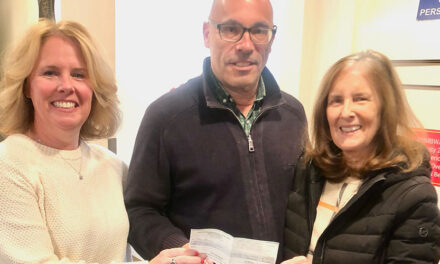Single rate remains
Published November 29, 2018
By MAUREEN DOHERTY
NORTH READING — For Fiscal Year 2019, the town’s new property tax rate will decrease slightly, to $15.58 per thousand of valuation.
The Select Board voted unanimously Nov. 19 to both establish this new tax rate and to keep the single tax rate in place for all classes of property – residential, commercial and industrial.
There has been only two years in the past when the board set a split tax rate between property classes, 1985 and 1988. Splitting the tax rate does not generate new revenue, it only re-allocates the levy burden, commented chief assessor Debbie Carbone. North Reading still has a very high percentage of residential property — 87.64% to be exact — compared to just 12.36% classified as commercial, industrial and personal property (CIP).
The new tax rate is a decrease of 76 cents per thousand of property valuation, but this rate is considered an estimated tax rate until it is certified by the state Department of Revenue (DOR).
Tax rate down, tax bill up
But what does the new tax rate mean for the average homeowner in town?
The average single family home is currently valued at $578,307, therefore the tax bill in FY19 will be $9,010.02 based on the new, lower rate of $15.58.
The average assessed value of residential properties in town has increased by $85,066 in the past year, therefore, even though the tax rate was 76 cents per thousand higher last year, the average homeowner had a tax bill of $8,060 for a home valued at $493,241.
The bottom line is the average homeowner will see an increased tax bill of $910 in the coming year due to the increase value of that home.
Last year’s tax rate was set 21 cents above the previous year’s rate which had followed two years of slight declines. The FY17 rate of $16.13 was a 28-cent per thousand decrease over the FY16 rate. However, the average value of a residential property in town was $502,121 in FY17 which created an average tax bill of about $8,100.
State-mandated process
The process of establishing a new tax rate each year is mandated by the state, as is the required property tax classification public hearing the board holds annually. During this hearing, in addition to maintaining the long-standing tradition of a single tax rate for all classes of property, the Select Board voted against establishing a residential tax exemption of up to a maximum of 20 percent that would allow a shift in the tax burden within this classification from those with the lowest assessed values for their principal residence to the highest assessed properties that do not serve as the principal residence of those taxpayers.
Under such a scenario, if the board had approved a 10% exemption, for example, the tax rate of the average assessed home would have remained neutral in FY19 ($9,010.02) while the tax burden for a below-average assessed property of $478,307 would realize a savings of $745.20 (paying $6,706.82 in taxes instead of $7,452.02) and the tax burden would have been shifted onto the higher than average assessed property by an equal amount. In the example provided by Carbone’s office, the taxes paid by a home valued at $1,000,307 would increase by $745.20 ($16,329.98 vs. $15,584.78) to offset the tax burden on the lower end properties.
Using the same property values, a 15% exemption would shift $1,117.80 from the lower end homeowner to the higher end homeowner ($6,334 tax bill vs. a $16,703 tax bill). A 20% exemption would essential double the shift cited in the first example by charging one property $1,490 less per year ($5,961) and the higher end property $1,490 more ($17,075). In communities where such tax shifts would work it is cited as enabling older homeowners on fixed incomes who are house rich but cash poor age in place.
No small commercial exemption
Similarly, the Selectmen chose not to adopt the small commercial exemption of up to 10 percent to shift the commercial class tax burden from “eligible parcels” to “ineligible parcels” as the town does not really have the eligible parcels required under the statute.
Per information compiled for the public hearing by Carbone, “eligible parcels” must have a valuation of less than $1M and must be owned by a business that employs fewer than 10 employees as certified by the state Dept. of Workforce Development–Division of Unemployment Assistance to the town’s Board of Assessors.
• The Select Board officially recommended that the town’s Board of Assessors set the FY19 tax rate at $15.58 per every thousand valuation.
• The Select Board set the town’s property tax levy for FY19 at $50,771,348.
• The board did not vote to allow a discount of up to 25 percent of the open space share of taxes because the Board of Assessors has determined that the town does not have any classified open space land, Carbone said. Open space is very narrowly defined as “land that is maintained in an open or natural condition which contributes significantly to the benefit and enjoyment of the public and which is not: subject to a permanent conservation restriction; held for production of income; or taxable under the provisions of Chap. 61 (forest land), Chap. 61A (farm land) or Chap. 61B (recreation land).”
By the numbers
Additional statistical information provided by Carbone about the town’s property values and classification include the following:
• Number of single family homes (4,267); residential condominiums (755); multi-family homes – up to 5+ units (74); mixed use properties (23); vacant residential land (225).
• Percentage of residential land: 87.64
• Percentage of commercial, industrial and personal property known as CIP: 12.36
The total tax levy in town from FY16 to FY19 is as follows:
• FY16: $45,829,889
• FY17: $47,348,590
• FY18: $49,007,070
• FY19: $50,771,348.




